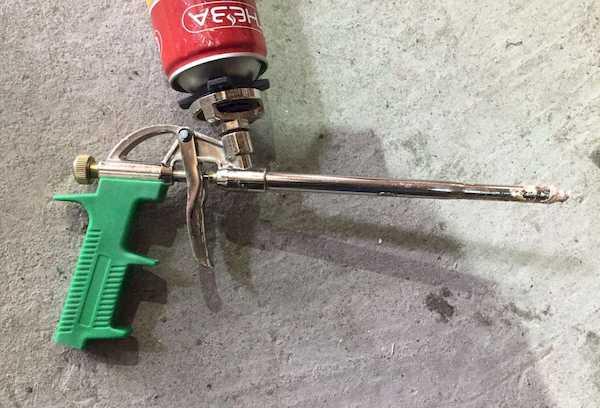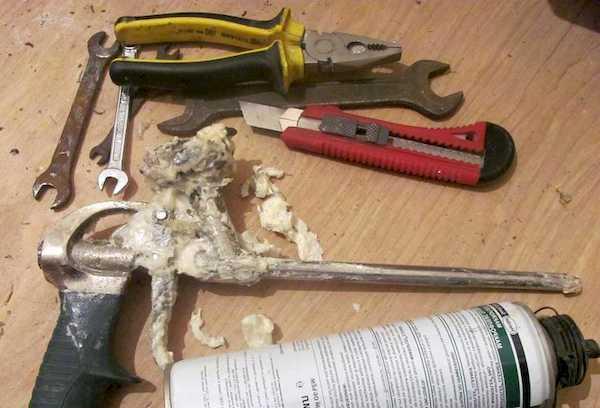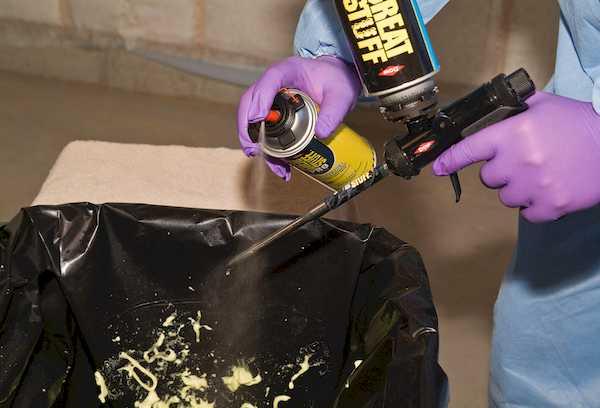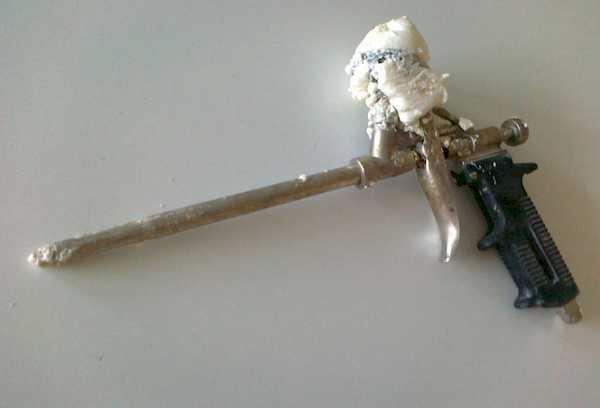How to clean a gun from dried foam and not buy a new one every time: washing with chemicals and a mechanical method
It is recommended that tools used to work with sealing compounds be put in order immediately. But if for some reason this did not work out, the question arises of how to clean the foam gun yourself when the foam dries inside. If you ignore flushing, this may negatively affect the operation of the device and lead to its premature failure.
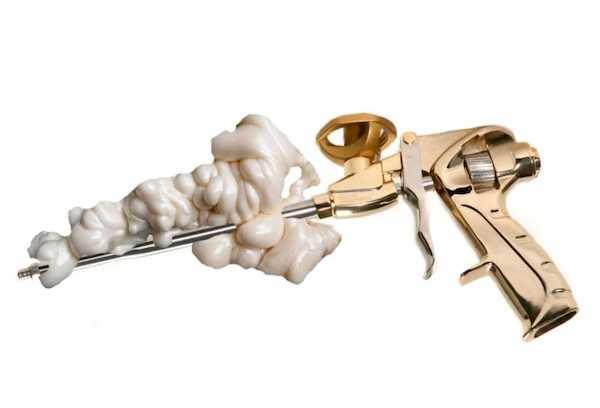
Methods for cleaning a gun from polyurethane foam
The easiest way to remove traces of sealant is when they are still fresh and have not had time to harden. That is, within 10-15 minutes after hitting the surface. In this case, it is enough to thoroughly wipe the working parts of the instrument with a dry cloth or special wipes. But if the foam has already dried, cleaning the gun will not be so easy. It is possible that even the use of special compounds will not help solve the problem, and they will need to be combined with a mechanical method of removing contaminants.
Chemical method
Most companies that produce sealants also produce removers at the same time. You can buy them in the same place where you buy polyurethane foam. These products are sold in the form of aerosols and solutions. The former are indispensable when cleaning solid instruments, the latter are more suitable for dismountable devices.Liquid washes can also be replaced with improvised means: purified gasoline, white spirit, kerosene, acetone-based solvent, etc.
How to rinse a gun with a spray can:
- Remove the foam container and put the aerosol in its place.
- Press down on the trigger, holding the gun with the hole down. Liquid should flow from the barrel. When it is clean and free of sealant particles, finish cleaning.
- Remove the can and pull the trigger again. If it moves jerkily, it means there are undissolved pieces inside the device. In this case, you will need to repeat the flushing.
- Reconnect the container with the cleaner and wait 10 minutes for small and old residues to completely dissolve.
- Pass a little more rinsing agent through the spout.
- Remove the can and store in a dry, dark place.
How to clean a gun from dried foam with a special liquid or solvent:
- Disassemble the instrument following the attached instructions. Careless or improper handling of the device can lead to thread breakage or damage to components.
- Place the parts in a deep and wide enough container. Elements should not lie in a pile. This will help save rinsing and improve the quality of cleaning.
- Pour in the solution so that it completely covers the parts of the gun and leave for half an hour.
- Remove the elements and wipe thoroughly with a clean, dry cloth. If foam residues are visible somewhere, soak these parts again.
Before you begin assembling the tool, it is worth treating its components with a small amount of machine oil. This will help prevent the gun from jamming during operation.
Mechanical method
Mechanical cleaning is recommended for heavy and old stains, when the foam has hardened so much that it cannot be affected by solvents and special removers.
The method involves completely disassembling the pistol, after which you will need to act in the following sequence:
- Using a knife with a sharp blade, cut off large, protruding pieces of foam on the outer parts of the instrument.
- Sand the surfaces with a stiff steel wool to remove any remaining sealant.
- Using a long strong wire, clean the inside of the barrel.
- Upon completion of work, assemble the tool.
If the inside of the “spout” is so dirty that a plug has formed in it, the listed measures will not be enough. In this case, additional cleaning will be required, which should be performed in this order:
- Using a twisting motion, make a through hole in the blockage using a stiff metal wire.
- Bend its end and use the resulting “hook” to remove the maximum amount of frozen foam.
- Pour a solvent or special composition into the barrel and leave for 30-40 minutes.
- Soak a coarse cloth with the remover, wrap it around a wire and remove any remaining foam from the inside of the “spout.”
- Assemble the device.
Before starting to assemble the gun after mechanical cleaning, experienced craftsmen advise treating the elements with an anti-corrosion agent, since the knife and wire leave scratches on the metal parts of the device.
During the first time after removing blockages when using the tool, foam may appear at the joints of the parts. This does not at all indicate a malfunction or incorrect assembly of the pistol. As you work with the sealant, the gaps will gradually seal.
Types of special means for cleaning the gun from polyurethane foam
Manufacturers offer several types of products with which you can clean the instrument from traces of foam yourself:
- Special napkins soaked in solution. Suitable not only for removing fresh traces of sealant, but also for cleaning clothes, hands and hair. The most popular brands are Lux clean and Uzin Clean-Box.
- Gentle action removers. Such compositions practically do not contain aggressive chemical additives. Most effective against uncured foam residues or minor dried stains. Suitable for cleaning both external and internal surfaces of instruments. Produced by the brands Profil, Tytan, Mastertex and Penosil Cleaner.
- Reagents with dimethyl ketone. These products contain strong chemicals that can dissolve extensive and long-standing stains. The aggressive components of such cleaners can be harmful to health, so you can only work with them if you follow safety precautions. The most popular types of strong solvents are Gover remover, Marcon, TechnoNIKOL Professional, Goldi Foam, Prifil.
Craftsmen recommend purchasing a cleanser along with foam and using removers immediately after finishing work. In the absence of systematic care, the instrument will quickly become unusable, and neither mechanical nor chemical compounds will help bring it into working condition. In this case, all that remains is to purchase a new device.
Precautions when cleaning the nail gun
When removing dried foam from a tool, the following safety rules must be observed:
- Do not clean the gun using chemicals near open flames or heating devices. You should also not smoke while using the remover. The same rule is also relevant when working with foam - most sealing compounds contain flammable elements.
- Hold the “nose” of the tool in the direction opposite to yourself. This will avoid contact of aggressive substances with exposed areas of the body, hair and clothing.
- Work with solvents wearing gloves, goggles and a mask. In addition to the skin of the hands and face, chemical components can damage the respiratory system, mucous membranes of the eyes and nose.
- Do not use the rinsing solution after the expiration date stated on the package.
- Clean the gun with chemicals outside or in a room with open windows, and after finishing work, ventilate for at least 30-40 minutes. The use of aggressive agents in confined spaces can lead to severe poisoning.
- If the barrel is clogged, do not use a drill to remove the plug. This can result in serious damage and breakdown of device parts.
- If the chemical composition gets on your skin, wash it off immediately under running water. You can use laundry soap, and after removing the composition from the body, treat these areas with a warm soda solution (1 teaspoon of soda per 200 ml of water). If signs of irritation or burns are visible on the affected part of the skin, visit a doctor.
- If the cleaner gets into your eyes, mouth or nose, remove the liquid and seek medical attention immediately. Also, do not postpone a visit to a specialist if, some time after finishing work, signs of intoxication appear (headache, pain in the stomach, nausea, vomiting, hyperthermia).
- Do not burn empty solvent or foam cans. When burned, the remaining contents will begin to release toxic fumes, which is unsafe for people and animals.
In addition, sealants and removers must be stored correctly. They should be kept away from heaters and fire sources. It is also necessary to protect the packaging from direct sunlight.
Rules for caring for a foam gun
Even under frequent use, a mounting gun can last a long time if you care for it properly. To do this, the following principles must be observed:
- Renew your stock of wash in a timely manner so that it is always at hand. It is advisable to use a product of the same brand as the sealant.
- If possible, clean the device immediately after finishing work. It is much easier to remove fresh foam residues than dried ones. In addition, when removing the hardened composition, there is a high probability of damaging the tool parts, especially if this is done mechanically.
- Pay special attention to the check ball, barrel and supply valve. These are the areas that are most susceptible to contamination.
- Do not attempt to remove remaining foam with water. The sealing composition has a porous structure and absorbs liquid well, making it more “sticky”. In this case, it will be much more difficult to eliminate it.
- If during the work you need to use foam of different brands, you will first need to completely squeeze out the old composition, rinse the gun, and only then install a new can.
- If the tool will not be used for 10-14 days, it is better not to remove the sealant bottle, but to store the gun with it, tightly screwing the pressure regulator.
- If the device is not used for a long period of time, periodically, approximately once every 2-3 months, perform preventative cleaning.
It is known that a good craftsman always has his tools in perfect order. If you treat them with care and keep them clean, you won’t have to think about buying new ones anytime soon.
